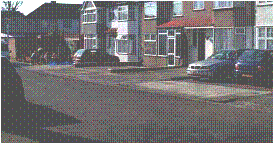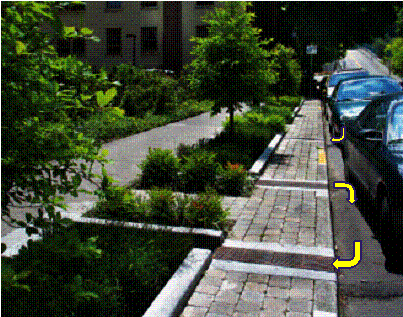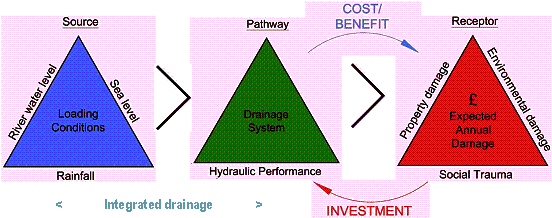Wastewater Forum Archive
WASTEWATER RESEARCH AND INDUSTRY SUPPORT FORUM
Meeting 2nd July 2009
Please note that for older reports some links will be to sites that are no longer active.
This was the Forum’s 38th meeting. It was held in the Boardroom of the Chartered Institution of Water & Environmental management (CIWEM) in London. Members of CIWEM’s Wastewater Management Panel joined the Forum for the technical presentations and discussion which were on the subjects of urban drainage and carbon accounting. The stresses on urban drainage systems are predicted to increase because of climate change and carbon accounting is going to be an important tool for managing climate changing emissions.
 In her thought provoking presentation entitled “Surface water disconnection initiatives: Progress and practicability”, Louise Hurley of the Pennine Group at Sheffield University likened surface water in an urban environment to a rebel without a cause. When it has nowhere to go or there’s too much of it, it causes trouble, but contended that like the rebel, it is more misunderstood than bad and that with imagination it can make a valued contribution to society.
In her thought provoking presentation entitled “Surface water disconnection initiatives: Progress and practicability”, Louise Hurley of the Pennine Group at Sheffield University likened surface water in an urban environment to a rebel without a cause. When it has nowhere to go or there’s too much of it, it causes trouble, but contended that like the rebel, it is more misunderstood than bad and that with imagination it can make a valued contribution to society.
 The street left is typical of suburban Britain with paved roads, sidewalks and front gardens. Rainwater is “not welcome” and encouraged to move on quickly, which is the cause of the problem. Contrast that with the street-scene right, from Portland in Oregon, USA where a chain of infiltration gardens has been retrofitted into the pavement. Surface water from the street and the sidewalk flows into and out of a chain of gardens, with some retained in each one and some infiltrating into the soil. As a consequence there is less water
The street left is typical of suburban Britain with paved roads, sidewalks and front gardens. Rainwater is “not welcome” and encouraged to move on quickly, which is the cause of the problem. Contrast that with the street-scene right, from Portland in Oregon, USA where a chain of infiltration gardens has been retrofitted into the pavement. Surface water from the street and the sidewalk flows into and out of a chain of gardens, with some retained in each one and some infiltrating into the soil. As a consequence there is less water  to enter the underground pipes and the water that does enters more gradually over a longer period of time so the pipe’s capacity is much less likely to be exceeded. The first section of each garden comprises Juncus reeds which tolerate submergence and filter debris. Portland has installed these “green streets” in areas where the infiltration capacity of the soil is
to enter the underground pipes and the water that does enters more gradually over a longer period of time so the pipe’s capacity is much less likely to be exceeded. The first section of each garden comprises Juncus reeds which tolerate submergence and filter debris. Portland has installed these “green streets” in areas where the infiltration capacity of the soil is
Richard Kellagher, HR Wallingford described recent research that led to a radical new approach to analysis of drainage system performance and asset management. It is called SAM: System-based Analysis and Management of urban flood risks and is a risk based procedure for drainage system analysis and management and is in line with the revised and updated SRM. For more information on SAM.
 SRM is the Sewerage Risk Management website which is the product of revising, updating, extending and developing the Sewerage Rehabilitation Manual 4th Edition. It presents an iterative, comprehensive risk based approach to the management of sewer system assets compatible with BS EN 752:2008 Drain and Sewer Systems Outside Buildings and the UKWIR Common Framework, and is able to take account of strategic drivers such as climate change adaptation and integrated urban drainage management. The key changes include:
SRM is the Sewerage Risk Management website which is the product of revising, updating, extending and developing the Sewerage Rehabilitation Manual 4th Edition. It presents an iterative, comprehensive risk based approach to the management of sewer system assets compatible with BS EN 752:2008 Drain and Sewer Systems Outside Buildings and the UKWIR Common Framework, and is able to take account of strategic drivers such as climate change adaptation and integrated urban drainage management. The key changes include:
- Performance assessment approach being explicitly risk based;
- Risk based tools are provided for many of the most important risks;
- Allowance of greater flexibility in the scale of analysis (not just drainage area);
- Hydraulic investigation updated to take account of latest technologies and the need for Integrated Urban Drainage Management;
- Sewer condition grading updated to include the new codes in MSCC4.

SAM’s project objective was to develop a risk based procedure for drainage analysis and management, but how was the risk to be weighted. Twelve partners across the drainage industry contributed to the £1,573,000 (half from UK government) project that ran from March 2006 to June 2009.
SAM quantified the relationship of flood volume deviation as a function of the area of the catchment; 78% of rainfall events have a variation of 4% volume deviation for a 50ha catchment and this increases to 24% of events having a 40% deviation for a 1000ha catchment. SAM used the National Property Dataset to evaluate the economic cost of flooding. An “Expected Annual Damage” (EAD) was calculated for each Impact Zone, this was an integration of all possible events to find an annualised value of Likelihood x Consequence.
Flooding frequency is still probably a fundamental measure. A particular EAD value could be from massive damage from very rare events, or lesser damage from relatively frequent events. SAM can be used with the traditional technique of using engineering judgement and basing decisions on reducing (or eliminating) flooding at selected Impact Zones and then re-evaluate the EAD to assess the cost-benefit of the scheme. Alternatively it can be used for optimisation by using GA [genetic algorithm] for evaluating a specific objective function, either to maximise EAD reduction for given investment or to minimise investment for to achieve a specified EAD reduction (network, nodes or Impact Zones).
SAM is a radical new approach to analysing system performance and asset management in line with the new SRM. It is extendable to all aspects of drainage, including environmental impact etc., but is subject to the ability/appropriateness of using cost functions as a measure of impact. It is compatible with “green streets” etc. that Louise Hurley talked about. Inevitably, future take-up of the method requires support from policy makers and regulators (OFWAT, Environment Agency, and Defra)
Stefania Galletti, WRc presented work that has been done to facilitate and implement carbon accounting and reporting for the water industry. Reporting has been required as part of the Ofwat “June Return” [of key data] since 2008.
The United Nations Framework Convention on Climate Change’s Kyoto Protocol is an international environmental treaty whose goal is "stabilization of greenhouse gas concentrations in the atmosphere at a level that would prevent dangerous anthropogenic interference with the climate system." . It is implemented in the UK by Climate Change Act 2008 and Climate Change Order 2009 ; these will have large impacts on the water industry which uses electricity at every stage of the water cycle (extraction, treatment, distribution and wastewater collection and treatment). The Carbon Reduction Commitment (CRC) will bring in carbon cap and trade . Of course water companies already generate a significant amount of non-fossil electricity from the biogas from sewage sludge treatment. This is increasing and has even greater potential if legislative inhibiters of co-digestion were removed.
In order to standardise reporting (so that companies can be compared fairly) UKWIR has developed a spreadsheet tool: the Carbon Accounting Workbook (CAW). The assumptions within the spreadsheet can be refined as knowledge about emissions from different aspects improves. Perversely the greenhouse gases with the largest global warming potential (GWP) factors are the ones about which there is most uncertainty around their emission factors. CO2 from burning biogas or oxidising organic matter is “short-cycle” (i.e. it was only ‘recently’ fixed from atmospheric CO2) and therefore has no GWP but CH4, N2O, etc. do have GWP but it is important that we get their emission factors right. In the case of biosolids used on farmland to replace fertiliser it is also important to recognise the collateral reduction in GWP because of this replacement.
 In her thought provoking presentation entitled “Surface water disconnection initiatives: Progress and practicability”, Louise Hurley of the Pennine Group at Sheffield University likened surface water in an urban environment to a rebel without a cause. When it has nowhere to go or there’s too much of it, it causes trouble, but contended that like the rebel, it is more misunderstood than bad and that with imagination it can make a valued contribution to society.
In her thought provoking presentation entitled “Surface water disconnection initiatives: Progress and practicability”, Louise Hurley of the Pennine Group at Sheffield University likened surface water in an urban environment to a rebel without a cause. When it has nowhere to go or there’s too much of it, it causes trouble, but contended that like the rebel, it is more misunderstood than bad and that with imagination it can make a valued contribution to society. The street left is typical of suburban Britain with paved roads, sidewalks and front gardens. Rainwater is “not welcome” and encouraged to move on quickly, which is the cause of the problem. Contrast that with the street-scene right, from Portland in Oregon, USA where a chain of infiltration gardens has been retrofitted into the pavement. Surface water from the street and the sidewalk flows into and out of a chain of gardens, with some retained in each one and some infiltrating into the soil. As a consequence there is less water
The street left is typical of suburban Britain with paved roads, sidewalks and front gardens. Rainwater is “not welcome” and encouraged to move on quickly, which is the cause of the problem. Contrast that with the street-scene right, from Portland in Oregon, USA where a chain of infiltration gardens has been retrofitted into the pavement. Surface water from the street and the sidewalk flows into and out of a chain of gardens, with some retained in each one and some infiltrating into the soil. As a consequence there is less water  to enter the underground pipes and the water that does enters more gradually over a longer period of time so the pipe’s capacity is much less likely to be exceeded. The first section of each garden comprises Juncus reeds which tolerate submergence and filter debris. Portland has installed these “green streets” in areas where the infiltration capacity of the soil is
to enter the underground pipes and the water that does enters more gradually over a longer period of time so the pipe’s capacity is much less likely to be exceeded. The first section of each garden comprises Juncus reeds which tolerate submergence and filter debris. Portland has installed these “green streets” in areas where the infiltration capacity of the soil is SRM is the
SRM is the 